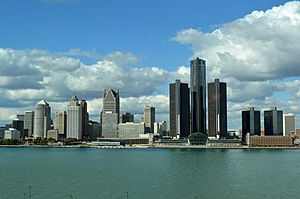Bankruptcy facts for kids
Bankruptcy is a legal process for when a person or a group, like a company, cannot pay their debts. It means they don't have enough money to cover what they owe. When this happens, they are legally called insolvent.
If a person can't pay their debts, the people they owe money to (called creditors) can ask a court to appoint a trustee in bankruptcy. This trustee is a professional who takes control of the person's belongings. Some things are protected by law, but the trustee sells other items. The money from these sales helps pay off as much of the person's debts as possible.
After this process, the person is discharged from bankruptcy. This means they are free from having to pay those old debts. However, it usually makes it harder for them to borrow money again. This is because their credit rating, which shows how good they are at paying debts, gets damaged.
When a company or organization can't pay its debts, creditors might ask the court to appoint a liquidator. A liquidator does a job similar to a trustee. They sell all of the organization's belongings. Unlike people, companies don't have protected assets. Once everything is sold, the organization is dissolved, meaning it stops existing. Companies don't get discharged from bankruptcy in the same way people do.
Contents
What is Insolvency?
People often mix up the words bankruptcy and insolvency. Insolvency simply means someone doesn't have enough money to pay their debts. It can also mean their total debts are more than their total assets (what they own).
Bankruptcy, on the other hand, is a formal legal process that happens in court. While the two words are connected, just because someone is insolvent doesn't always mean they will go through bankruptcy.
Ways to Avoid Bankruptcy
Many countries offer other options to help people and businesses avoid the full bankruptcy process. These options try to help people deal with their debts without losing everything.
For individuals, there are often individual voluntary arrangements (or IVAs). In an IVA, creditors agree to accept less money to settle the debts. This helps the person avoid bankruptcy.
Companies and other organizations have similar processes. These might be called schemes of arrangement in many countries. They allow businesses to work out new payment plans with their creditors.
Bankruptcy Protection for Businesses
In many countries, a company or business can ask courts for bankruptcy protection. This helps protect the business from its creditors. Without this protection, creditors might break up the business and sell off its parts.
The main goal of bankruptcy protection is to give the business more time. This time allows the business to reorganize itself. It can then work out a new agreement between its owners and the people it owes money to. In many countries, this is called going into administration. In the United States, it's often called going into Chapter 11.
However, not all countries have laws that offer bankruptcy protection for businesses.
Knowing Your Rights
Sometimes, people who owe money (called debtors) are threatened by creditors. They might not know they have a right to go through the bankruptcy process. This can be a problem in some places.
Also, some creditors might keep bothering a debtor even after bankruptcy laws say they shouldn't. They hope the debtor will pay them money they don't legally have to. It's important for debtors to know their rights and protections under bankruptcy laws.
Bankruptcy in the United States
In the United States, there are different types of bankruptcy. Chapter 7 of the U.S. Bankruptcy Code can be used by businesses or individuals. It's sometimes called liquidation bankruptcy. This is because some of a debtor's property might be sold (liquidated) to pay creditors.
Chapter 13 is another common type of bankruptcy for individuals in the United States. When a business is in debt and cannot pay, it might file for Chapter 7 in court. A Chapter 7 filing usually means the company will stop operating. Employees often lose their jobs when a company files for Chapter 7. When Chapter 7 is filed, a trustee is chosen. This trustee manages the business and sells its assets to pay the creditors.
Images for kids
-
Failure of John Law's Mississippi Company led to French national bankruptcy in 1720.
See also
 In Spanish: Quiebra para niños
In Spanish: Quiebra para niños



